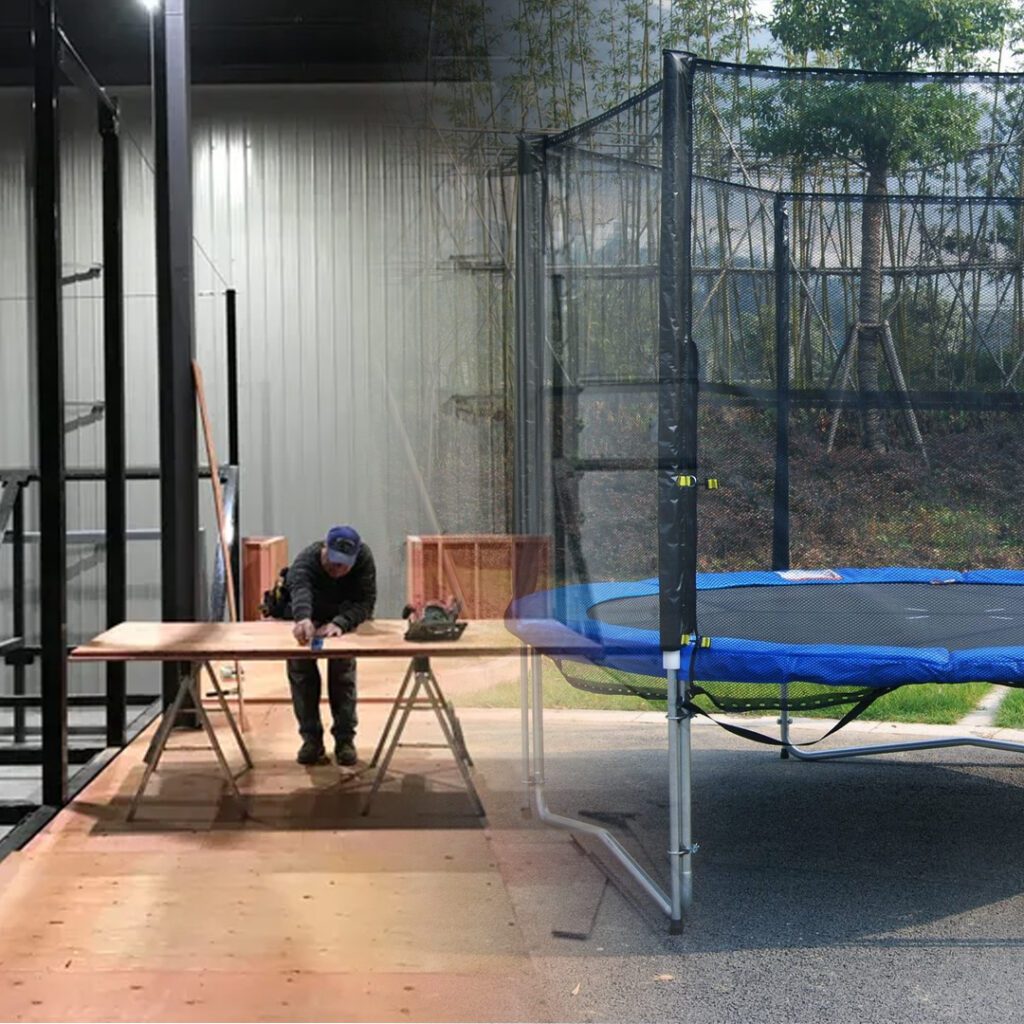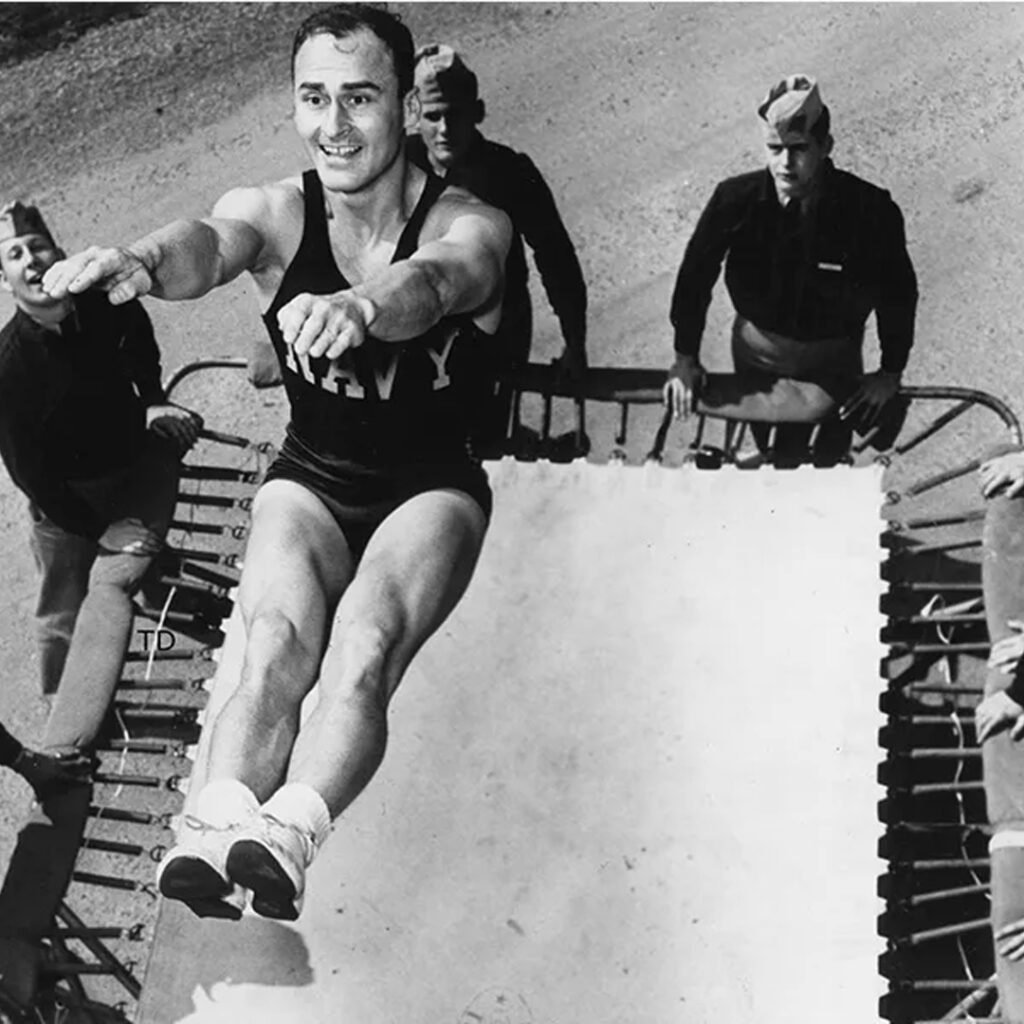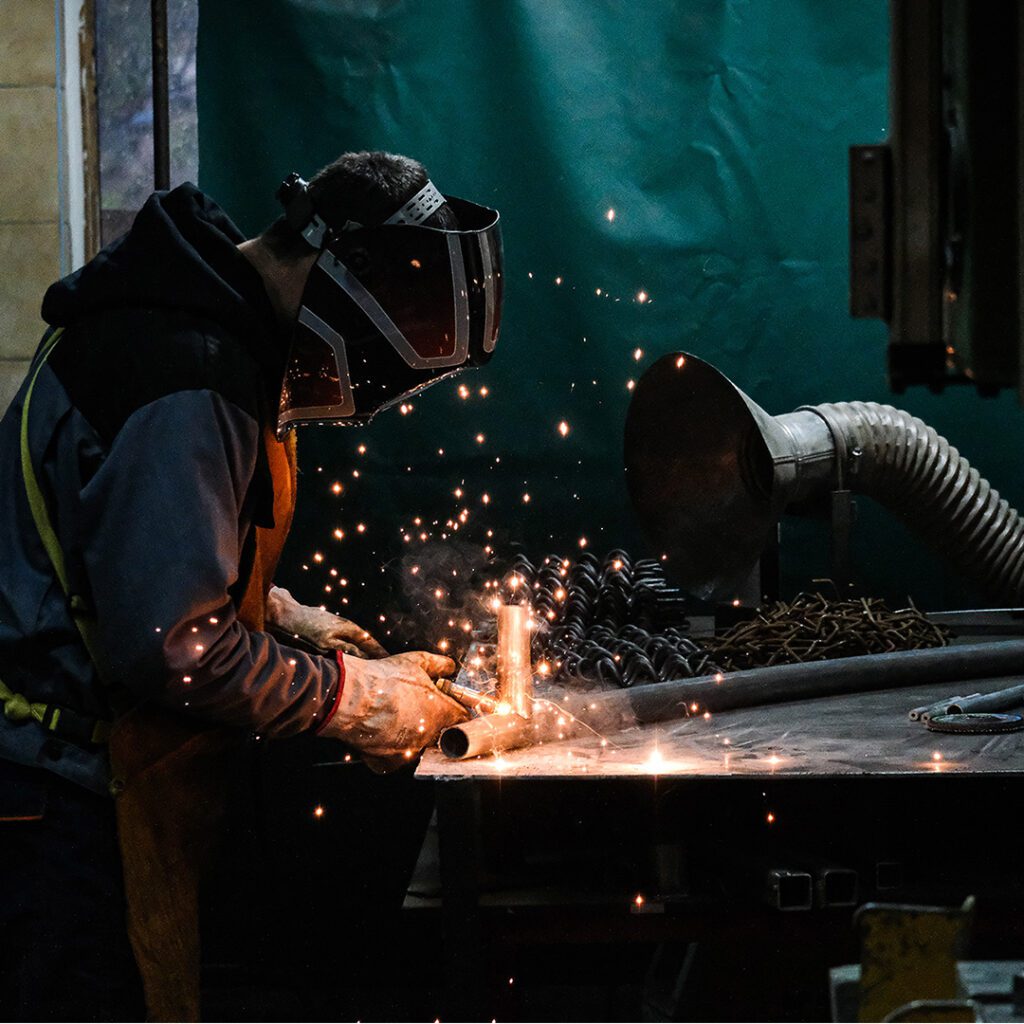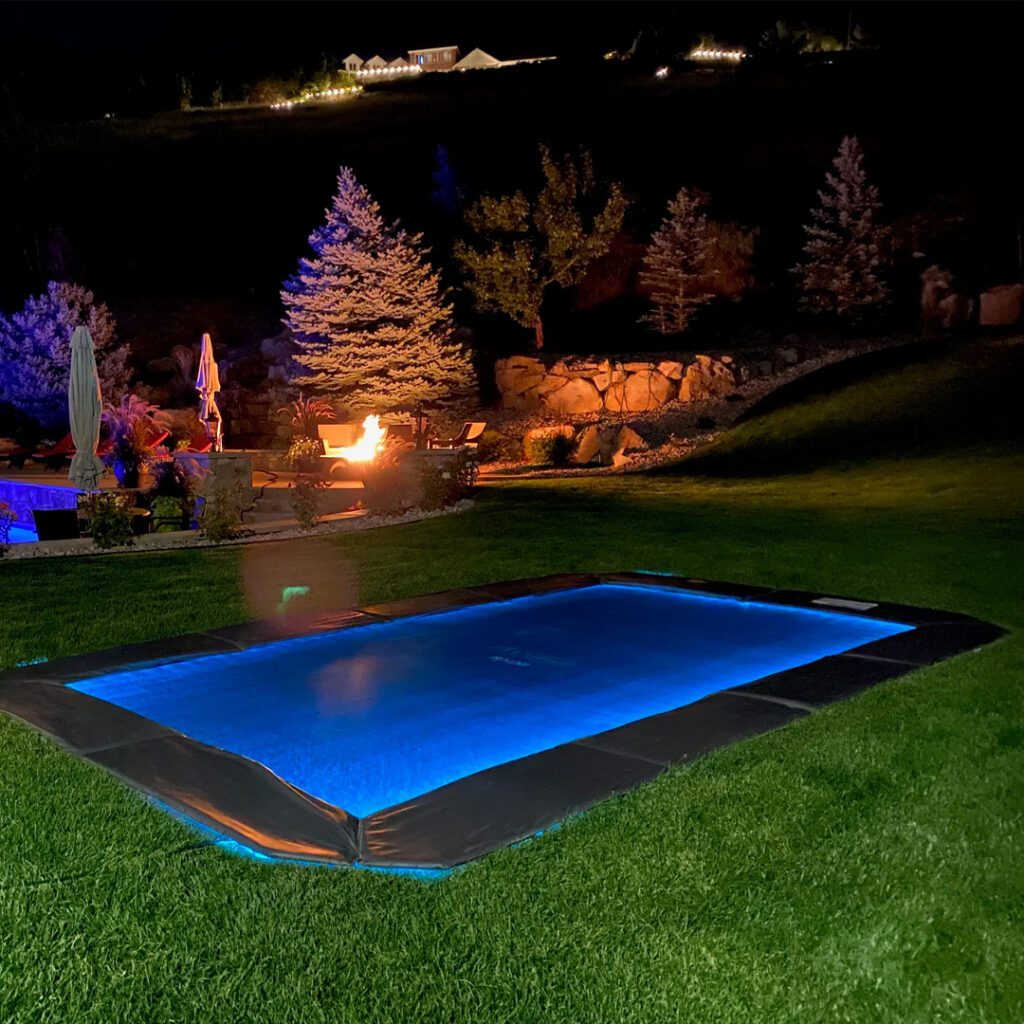
Have you ever wondered what goes into making those bouncy trampolines you see at the gym or in competitions? Well, we will be taking a behind-the-scenes look at the techniques and technologies involved in constructing a professional-grade sport trampoline. From the intricacies of the frame to the specialised fabrics that make up the bed, we’ll guide you through what makes these seemingly simple instrument capable of launching athletes to incredible heights.
Whether you’re an aspiring trampolinist looking to understand your equipment better or just fascinated by the engineering feats behind competitive sports, we will guide you how sport trampoline is made and how it evolved with time
Historical Perspective:

Trampolining as a competitive sport has come a long way since the first modern trampoline was designed in the 1930s, before becoming the current trend in the UK. In the early days, trampolines were mainly used for entertainment and recreation. It wasn’t until the 1950s that the first organised competitions began to emerge.
The first World Trampoline Championships were held in 1964, and trampolining debuted as an Olympic sport in 2000 at the Sydney Games. Since then, the sport has continued to evolve at a rapid pace. Some of the most significant milestones include:
- The development of safety standards for trampoline construction and padded frames in the 1970s to reduce injuries. This helped popularize trampolining among recreational users and competitors.
- The introduction of double mini-trampolines in the 1980s added a new dimension to the sport with aerial skills and manoeuvres.
- Advances in trampoline technology, using stronger, more rigid materials that provide more lift and allow athletes to perform more complex skills. The trampoline bed evolved from canvas to nylon to Permatron, and now high-performance Permatron.
- The inclusion of trampolining in major competitions like the World Games in 1981 and the Olympic Games in 2000 propelled the sport into the mainstream and inspired many aspiring trampolinists.
- Standardized judging criteria and degree of difficulty ratings developed in the 1990s and 2000s made trampolining more appealing as a competitive sport.
Trampolining has a fascinating history and continues advancing in new directions. While still a niche sport, trampolining has captured the sports market with an exciting acrobatic discipline and Olympic event.
Techniques in Trampoline Construction

The frame is one of the most important parts of a trampoline. Historically, trampoline frames were made of steel, which is durable but can rust over time. Many modern trampolines now use galvanized steel, which is steel coated in zinc to prevent rusting, or aluminum, which does not rust at all. Aluminum frames are often considered superior as they are lighter, more resistant to weather, and can last longer. However, aluminum may dent more easily. The shape and size of the frame also impacts performance, with round frames typically providing the most even, predictable bounce.
The springs are what give the large trampoline its bounce. Longer, sturdier springs made of galvanized steel are best for achieving maximum height and soft landings. The number of springs also matters, with more springs providing a firmer, more powerful bounce. The spring configuration should be evenly spaced around the edge of the mat for the best performance and stability.
For the jumping surface, polypropylene mats are a popular choice. They are water-resistant, UV-treated for outdoor use, and provide an excellent, high-energy bounce. The mat should have a non-slip surface with lots of small perforations to allow air flow and prevent overheating on hot days. Padding around the springs and frame provides extra safety, and net enclosures can help contain jumpers on the mat.
The techniques and technologies used in manufacturing sport trampolines have advanced a great deal from their early days. By carefully selecting high-quality, rust-resistant materials for the frame, springs and mat, and optimizing the design and construction, modern trampolines can provide a safe yet thrilling experience for recreational and competitive jumpers alike.
Technological Innovations:

Trampolines have undergone remarkable transformations in recent times, marked by the integration of cutting-edge safety features, you should be following the safety hacks though. As the popularity of interactive and “smart” trampolines continues to rise, manufacturers are prioritising not only the entertainment value but also the prevention of injuries.
Interactive and Smart Features
- Built-in sensors, games, and tracking systems in trampoline parks enhance user engagement.
- LED lights, music, and interactive games respond to the user’s movements.
- Jump metrics like height, flips, and calories burned are tracked and accessible through dedicated mobile applications.
Revamped Safety Components
- Safety pads and nets have seen substantial improvements in both materials and design.
- Thicker, higher-density foam pads provide superior protection during jumps.
- Tightly-woven nets with robust construction effectively prevent falls and injuries.
Innovative Design for Enhanced Safety
- Some trampolines incorporate “double bounce” pads and nets for added stability.
- This feature contributes to increased safety, reducing the risk of accidents during jumps.
In summary, the advancements in trampoline safety features aim not only to improve the enjoyment of the activity but also to create a secure environment for users. With interactive elements and enhanced safety components, modern trampolines cater to the preferences of thrill-seekers while addressing the concerns of safety-conscious individuals.
Environmental Considerations:
These days, it’s important for companies to consider the environmental impact of their products and operations. Trampoline manufacturers are no exception. Many brands now use sustainable, eco-friendly materials and efficient production methods to reduce their carbon footprint.
Sustainable Materials
Instead of materials like petroleum-based plastics, many trampoline brands now use recycled steel and aluminum for the frame, mat, and trampoline springs. The padding and safety netting may be made from recycled PET fibers from plastic bottles. These recycled materials drastically cut down on the waste sent to landfills. Some brands also use timber from sustainable forestry operations for structural parts.
Energy-efficient Manufacturing
The manufacturing process itself has also become more energy efficient and environmentally friendly. Many factories use renewable energy like solar or wind power to reduce emissions. They are also improving production lines to cut down on wasted materials and increase efficiency. Simple things like turning off equipment and lights when not in use, and improving insulation and temperature control systems all help lower the overall energy usage.
The trampoline industry’s move towards sustainability and energy efficiency is an important step in the right direction. By choosing eco-friendly materials and production methods, brands are able to provide high-quality, affordable products while also reducing pollution and conserving natural resources. As a consumer, you can support these environmental efforts by purchasing from brands committed to sustainability. Together, we can all work to minimize the impact of trampolines and ensure the sport is able to be enjoyed for generations to come.
Challenges and Solutions:

A major challenge in building trampolines is ensuring maximum bounce and stability. The tension, quality and placement of the springs and mat are key factors. Improving spring design and mat materials can enhance performance.
Springs
The springs provide the lift that gives trampolines their signature bounce. Stronger, higher-tension springs made of galvanized steel allow for bigger air time and more advanced skills. However, over-tightening the springs can reduce stability and make the mat uneven. A balance of spring tension is needed for optimal bounce and safety.
Mat
The mat, or jumping surface, which is used for jumping tricks must be both springy and durable. Early trampolines used canvas mats, now mostly replaced by UV-resistant polypropylene nets or pads. Newer mat materials like Permatron polypropylene provide superior bounce, weather-resistance and longevity. Multiple layers or ‘plies’ of mat material also improve bounce and prevent tearing. However, more plies mean higher cost and weight.
Frame
The frame must securely support the weight and forces generated by jumpers. Round trampoline frames are simplest but square or rectangular frames allow for more advanced moves. Galvanized or powder-coated steel is frequently used, as it resists weathering while providing structural stability. However, steel frames can become unstable or damaged over time without proper maintenance. Reinforcing the frame with strong, weather-resistant materials helps ensure safety and longevity.
Future Trends:

Sport trampolines have come a long way since their invention in the 1930s. As technology and materials advance, trampolines are becoming more high-tech, safe and accessible. Here are a few trends we expect to see emerging in the coming years:
Improved safety features
Safety pads, nets and harnesses will continue to improve, featuring smarter designs and higher quality, durable materials to prevent injuries. Electronic sensors may even be integrated to detect when a jumper is approaching the edge of the trampoline bed.
Interactive and “smart” trampolines
Trampolines are poised to get an interactive, high-tech makeover. Some may feature built-in games, lights and sounds. “Smart” trampolines could track a jumper’s height, flips and other stats to provide performance feedback and help improve skills over time.
Alternative shapes and sizes
While the classic round trampoline will always remain popular, alternative shapes like rectangles, hexagons and octagons provide unique bouncing experiences. We’ll also see more variety in trampoline sizes to suit both residential and commercial needs. Mini trampolines and in-ground trampoline models will gain more traction for home use.
Accessibility features
Trampoline manufacturers will likely make their products more accessible to people of all abilities. This could include wheelchair ramps, harnesses and other support features so that people with disabilities can also enjoy the fun of trampolining.
The trampoline industry is primed for innovation as companies explore new technologies, shapes, sizes and features to improve safety, accessibility and the overall user experience. The future of trampolining looks very bounce-worthy indeed!
Conclusion
From the tightly woven fabrics to the spring systems calibrated for just the right bounce, it’s clear there’s more science in these familiar backyard toys than meets the eye. Whether you’re a trampoline engineer looking to push the design envelope, or just someone who appreciates the hidden complexity in everyday things, hopefully you’ve gained a new appreciation for all the thought and precision that allows us to soar to such impressive heights on nothing more than a stretchy bit of fabric. Next time you find yourself bouncing skyward, take a moment to reflect on the deceptively simple joy made possible by some serendipitous science.





